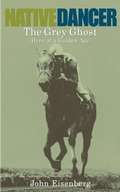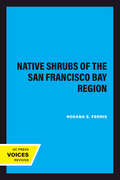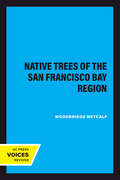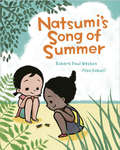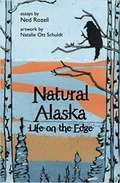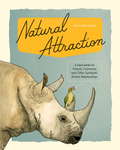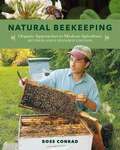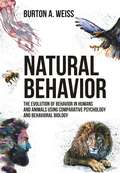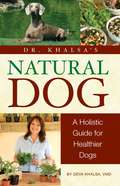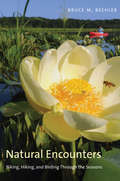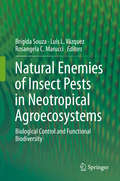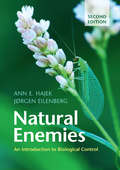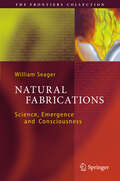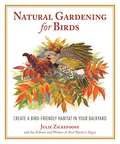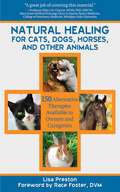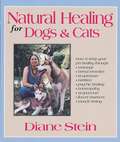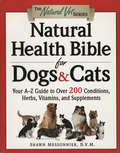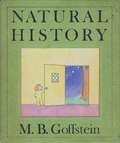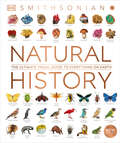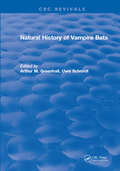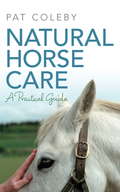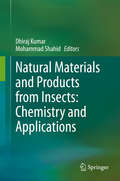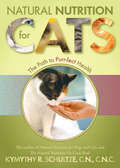- Table View
- List View
Native Dancer: The Grey Ghost Hero of a Golden Age
by John EisenbergIn the early 1950s, a rising star flickered across millions of black-and-white TV sets. Nick-named 'The Grey Ghost,' Native Dancer was a blue-blood thoroughbred with a taste for drama, courtesy of his come-from-behind running style, and impressive credits: He finished first in 21 of his 22 career starts, his only loss by a nose in the 1953 Kentucky Derby; was named Horse of the Year-twice; and was inducted into the National Museum of Racing's Hall of Fame. His popularity was so great, Time® magazine put him on its cover, and TV Guide named him one of America's top three TV stars, along with Ed Sullivan and Arthur Godfrey. Legend says his ghost haunts Churchill Downs. Set against the nostalgic events of an America long past, NATIVE DANCER is the definitive account of one of the greatest champions of horse racing's golden age.
Native Shrubs of the San Francisco Bay Region (California Natural History Guides #24)
by Roxana S. FerrisThis title is part of UC Press's Voices Revived program, which commemorates University of California Press’s mission to seek out and cultivate the brightest minds and give them voice, reach, and impact. Drawing on a backlist dating to 1893, Voices Revived makes high-quality, peer-reviewed scholarship accessible once again using print-on-demand technology. This title was originally published in 1968.
Native Trees of the San Francisco Bay Region
by Woodbridge MetcalfThis title is part of UC Press's Voices Revived program, which commemorates University of California Press’s mission to seek out and cultivate the brightest minds and give them voice, reach, and impact. Drawing on a backlist dating to 1893, Voices Revived makes high-quality, peer-reviewed scholarship accessible once again using print-on-demand technology. This title was originally published in 1959.This title is part of UC Press's Voices Revived program, which commemorates University of California Press’s mission to seek out and cultivate the brightest minds and give them voice, reach, and impact. Drawing on a backlist dating to 1893, Voices Revived</DIV
Natsumi's Song of Summer
by Robert Paul WestonThis sweet and gentle picture book celebrates summer in Japan, as one little girl shares her love for bugs with her cousin who is visiting from America.Two young cousins who are separated by language, continent and culture meet for the first time when Jill's family travels from America to Japan to stay with Natsumi's family during the summer holidays. Natsumi's nervousness about meeting her cousin from across the sea quickly disappears when she discovers that her cousin is a lot like her: they both love summertime's hot sandy beaches, cool refreshing watermelon, festivals and fireworks. Then Jill asks Natsumi about the strange buzzing sound that comes from the nearby trees, and Natsumi is nervous once again. What if Jill is frightened of Natsumi's cherished cicadas, the insects that sing the music of summertime? This is a tender, evocative story that celebrates the special pleasures of summertime and of reunions with faraway family and friends.
Natural Alaska: Life on the Edge
by Ned RozellPioneer creatures at the limits of their range do remarkable things to survive. Ned Rozell has been one of those animals living at the edge of civilization in Fairbanks, Alaska. The frogs, bats and flying squirrels that share that subarctic space are the subject of the science and natural history writer's book, illustrated by a lifelong Alaskan.
Natural Attraction: A Field Guide to Friends, Frenemies, and Other Symbiotic Animal Relationships
by Iris GottliebBest buds, frenemies, freeloaders, bullies, copycats, hangers-on. We’re accustomed to all types of people and human interactions. But animal relationships can be just as weird and complex. For anyone who’s ever felt a bit awkward in their relationships, wait until you hear about how complicated things get in the animal world. This funny and enlightening gift book depicts charming and unusual symbiotic animal relationships in all their awkward glory. Through delightful watercolor illustrations and funny yet scientifically accurate text, Iris Gottlieb explores the symbiotic relationships of 35 odd, cute, and unpredictable animal pairs. Here are stories of vampires, cannibalism, mimicry, parasites, and more. You’ll learn a lot about nature--and human nature--as you recognize traits of your own friends, frenemies, and enemies in this insightful, amusing look into the secret lives of animals.From the Hardcover edition.
Natural Beekeeping: Organic Approaches to Modern Apiculture
by Ross ConradWhether you are a novice looking to get started with bees, an experienced apiculturist looking for ideas to develop an integrated pest-management approach, or someone who wants to sell honey at a premium price, this is the book you&’ve been waiting for.Now revised and updated with new resources and including full-color photos throughout, Natural Beekeeping offers all the latest information in a book that has already proven invaluable for organic beekeepers. The new edition offers the same holistic, sensible alternative to conventional chemical practices with a program of natural hive management, but offers new sections on a wide range of subjects, including:The basics of bee biology and anatomyUrban beekeepingIdentifying and working with queensParasitic mite controlHive diseasesAlso, a completely new chapter on marketing provides valuable advice for anyone who intends to sell a wide range of hive products.Other chapters include:Hive ManagementGenetics and BreedingThe Honey HarvestThe Future of Organic BeekeepingRoss Conrad brings together the best &“do no harm&” strategies for keeping honeybees healthy and productive with nontoxic methods of controlling mites; eliminating American foulbrood disease without the use of antibiotics; selective breeding for naturally resistant bees; and many other detailed management techniques, which are covered in a thoughtful, matter-of-fact way.
Natural Behavior: The Evolution of Behavior in Humans and Animals using Comparative Psychology and Behavioral Biology
by Burton A. WeissNatural Behavior provides seminal insights into the evolution of animal and human behavior for enthusiasts of Comparative Psychology and Behavioral Biology. Evolution and the behavior of the animal kingdom are discussed with new concepts on science, learning and instinct, and population phenomena. Hominization, interaction with Neanderthals, how the brain evolved, and the impact on the World are described with new views.The origin of our scientific concepts and the trend away from the egocentric position, placing humans at the center of the universe, is considered, along with the status of religion and how the fit with science is positive. This volume carefully explains evolution and the central role of behavior in natural selection. The range of animal behavior from single cells to people is covered, as are, topics like European settling of the New World first, and the effects of humans on the planet.
Natural Cures for your Dog and Cat: Low Cost Natural Cures Your Vet Doesn’t Want You to Know
by John HeinermanAN INVALUABLE EVERYDAY resource for every dog and cat lover, Natural Cures for your Dog and Cat offers safe, effective, all-natural remedies for 63 common health problems that affect dogs and cats. Dr. Heinerman includes everything from allergies, arthritis, cancer and constipation to worms and wounds. You'll also find useful information on diet and nutrition, along with natural solutions to behavioral problems such as barking, biting and scratching. Plus a new first aid for pets section that could save your pet's life in an emergency.
Natural Dog
by Bowtie Inc.In Dr. Khalsa's Natural Dog, pioneering veterinarian Deva Khalsa comes to the aid of dog owners by sharing her effective, integrative approach to natural health and healing for dogs.BONUS! 50 healthy and tasty recipes - including doggy birthday cakes!
Natural Encounters: Biking, Hiking, and Birding Through the Seasons
by Bruce M. BeehlerA twelve-month excursion through nature’s seasons as recounted by a lifetime naturalist In this “personal encyclopedia of nature’s seasons,” lifetime naturalist Bruce Beehler reflects on his three decades of encountering nature in Washington, D.C. The author takes the reader on a year-long journey through the seasons as he describes the wildlife seen and special natural places savored in his travels up and down the Potomac River and other localities in the eastern and central United States. Some of these experiences are as familiar as observing ducks on the National Mall in Washington, D.C., or as unexpected as collecting fifty-million-year-old fossils on a Potomac beach. Beyond our nation’s capital, Beehler describes trips to nature’s most beautiful green spaces up and down the East Coast that, he says, should be on every nature lover’s bucket list. Combining diary entries, riffs on natural subjects, field trips, photographs, and beautiful half-tone wash drawings, this book shows how many outdoor adventures are out there waiting in one’s own backyard. The author inspires the reader to embrace nature to achieve a more peaceful existence.
Natural Enemies of Insect Pests in Neotropical Agroecosystems: Biological Control and Functional Biodiversity
by Brígida Souza Luis L. Vázquez Rosangela C. MarucciThis book aims to address the importance of natural enemies and functional diversity for biological control in Neotropical agroecosystems. Several aspects related to the conservation of natural enemies, such as vegetation design and climate change, are discussed in Part 1 and the bioecology of several insects groups used in biological control in Latin America is presented in Part 2. Part 3 is devoted to mass production of natural enemies while Part 4 describes how these insects have been used to control of pests in major crops, forests, pasture, weeds and plant diseases. Lastly, Part 5 reports Latin-American experiences of integration of biological in pest management programs.
Natural Enemies: An Introduction to Biological Control
by Ann E. Hajek Jørgen EilenbergThis second edition of Natural Enemies will give students, professionals, and anyone wishing to learn the basics of biological control a fully updated and thorough introduction. The book discusses the huge diversity of organisms used in the control of pests, weeds and plant pathogens, and compares the many different strategies referred to as 'biological control': the introduction of exotic natural enemies, application of predators, parasitoids, and microorganisms as biopesticides, and manipulation of the environment to enhance natural enemy populations. The authors present the ecological concepts which form the bases of biological control and discuss recent changes to make biological control safe for the environment. Case studies are included throughout, providing in-depth examples of the use of different organisms and strategies in a variety of ecosystems. A new chapter covers the current challenges; the impact of climate change, the problem of invasive species, and how biological control can aid sustainability.
Natural Fabrications
by William SeagerThe spectacular success of the scientific enterprise over the last four hundred years has led to the promise of an all encompassing vision of the natural world. In this elegant picture, everything we observe is based upon just a few fundamental processes and entities. The almost infinite variety and complexity of the world is thus the product of emergence. But the concept of emergence is fraught with controversy and confusion. This book ponders the question of how emergence should be understood within the scientific picture, and whether a complete vision of the world can be attained that includes consciousness.
Natural Gardening for Birds: Create a Bird-Friendly Habitat in Your Backyard (Rodale Organic Gardening Book Ser.)
by Julie ZickefooseA Practical Illustrated Bird-Oriented Gardening Book with Great Reference ChartsBird-watchers everywhere dream of a landscape dotted with fruiting shrubs, nests tucked into twining vines, and birds flocking to feeding stations. Let Natural Gardening for Birds show you how to lay out the welcome mat for birds by considering all of their needs, including year-round food, water, and shelter. Whether you’re looking to create a hummingbird garden, install a water feature, create alluring perches, or simply designate a corner of your property as a natural area, you’ll find all the inspiration and information you need in Natural Gardening for Birds, including:The best plants for nectar, fruit, and seedsThe most attractive foods to offer birdsHousing for cavity-nesting birdsSimple habitat enhancements like snags and perchesRegion-specific planting ideas and charts
Natural Healing for Cats, Dogs, Horses, and Other Animals: 150 Alternative Therapies Available to Owners and Caregivers
by Lisa Preston Race FosterIn addition to traditional veterinary treatments, a wide range of alternative approaches to are becoming more main stream. Natural Healing for Cats, Dogs, Horses and Other Animals will help pet owners and caretakers understand their options. The author provides valuable advice and shows how to select a practitioner and to determine whether more than one alternative therapy is appropriate. We all want to give our pets the happiest, healthiest life possible-here is a book that shows the way!
Natural Healing for Dogs and Cats
by Diane SteinThis invaluable resource tells how to use nutrition, minerals, massage, herbs, homeopathy, acupuncture, acupressure, flower essences, and psychic healing for optimal health.Meticulously researched.Fully illustrated.Comprehensive guide to holistic healing methods.Extensive resource directory.Effective ways to reduce veterinary costs.From the Trade Paperback edition.
Natural Health Bible for Dogs & Cats: Your A-Z Guide to Over 200 Conditions, Herbs, Vitamins, and Supplements
by Shawn Messonnier2000 Winner, Better Health for Life Award, Cat Writer's Association (CWA) When it comes to your dog's or your cat's health, you want the best health care available. But did you know that conventional medicine is not the only answer, or even the best answer? Inside you'll learn from a respected veterinarian how the therapeutic wonders of natural medicine can benefit your dog or cat. This comprehensive guide discusses more than 40 common conditions or diseases that can affect your pet and how they can be treated or improved with natural medicine. Easy to understand and use, with cross-references between conditions and treatments, this informative resource includes: ·An A-Z guide to common health conditions ·An A-Z guide to herbs, vitamins, and supplements ·Dietary recommendations for specific health concerns ·Proven complementary therapies for your pet ·And much, much more! Do your pet a great favor--add this complete reference to your library. You'll both be glad you did. Inside, natural treatments for: ·Allergies ·Obesity ·Cancer ·Kidney Disease ·Arthritis ·Heart Disease ·Feline Leukemia ·Dental Disease ·Ear Infections ·And many more common conditions "Incredibly well thought-out and organized. This bible will serve as an excellent reference for veterinarians and pet owners alike. "--L. Phillips Brown, D. V. M. , product manager, Inter-Cal Nutraceuticals "A concise overview of common animal conditions and available complementary therapies that will help readers ensure their pets and patients receive the best treatment. "--Myrna Milani, D. V. M. , author,Preparing for the Loss of Your Pet "This bible is a 'new testament' that may help pet caregivers heal their sick pets. "--Alice Villalobos, D. V. M.
Natural History
by M. B. GoffsteinText and illustrations descibe the riches of the earth and how people can promote peace and goodwill by sharing equitably with each other and their fellow creatures.<P><P>Jane Addams Children’s Book Award Winner
Natural History (DK Definitive Visual Encyclopedias)
by DKA spectacular and exceptionally well-illustrated guide to everything on Earth. From rocks to redwoods and microbes to mammals – this is a dazzling visual introduction to our planet&’s treasures.Filled with more than 5,000 species and in-depth studies of animals, plants, fungi, microorganisms, rocks, and minerals, it&’s the ultimate celebration of the world&’s extraordinary diversity of life. Planet Earth's eclectic wildlife and endless wonders come to life in the most spectacular way in this monumental compendium of Earth&’s natural wonders. Compiled by a team of professional wildlife experts working with the world-renowned Smithsonian Institution, this comprehensive nature book was 5 years in the making!This unrivaled visual survey of Earth's natural history looks at every kingdom of life. It is packed with thousands of eye-popping, specially commissioned photographs and in-depth two-page spreads on incredible species. The engaging and informative text was supplied by a global team of natural history experts to make this bold visual encyclopedia a perfect addition to every family bookshelf or school library.From the evolution of nature to the classification of species, Natural History begins with a general introduction to life on earth. The next chapters form an extensive and accessible catalog of species and specimens – from flowering plants to reptiles – interspersed with fact-filled introductions to each group and in-depth profile features. A True Visual Dictionary of Earth's Natural WondersNatural History squeezes as many plants, animals, rocks, and minerals as possible between its covers. This extraordinary reference book from DK Books is eye candy for nature lovers of all ages, and makes a fantastic gift!Explore everything on Earth, such as: • Living earth • Minerals, rocks, and fossils • Microscopic life • Plants • Fungi • Animals
Natural History of Vampire Bats
by Arthur M. GreenhallA major problem with vampire bats is that whatever information exists is scattered throughout the literature or is not recorded. There are some excellent books on the ecology and biology of bats with very little on vampire bats. This volume fills that gap to provide an in-depth presentation of these unique animals.
Natural Horse Care
by Pat ColebyThis practical and definitive guide explains how to keep horses in excellent health the natural way.The vital roles of correct feed rations, vitamins and minerals in the health of a horse are fully explained; and practical guidance is given on topics such as selecting the right food, treating ailments with natural remedies, dealing with recovery from injury, and combating equine flu.Trainers, breeders and horsekeepers of all kinds will benefit enormously from Pat Coleby's many years of experience working with horses in the UK and Australia. She is a qualified vet, and also the author NATURAL PET CARE.
Natural Materials and Products from Insects: Chemistry and Applications
by Dhiraj Kumar Mohammad ShahidThis book reviews the latest research on bioproducts from various economically important insects, such as silkworms, honey bees, lac and drosophila, and termites, and discusses their general, biomedical and industrial applications in detail. It includes chapters focusing on insects as a food source, probiotics, silk-based biomaterials, insect pheromones, insects as biomedicine source, pupa oil chemistry, non-protein compounds from Lepidopteran insects, insect chitin and chitosan, polyphenols and flavonoids.Model insects like Bombyx mori or bees were domesticated in Asian countries thousands of years ago. Over time, natural products from these animals became industrialized and today they attracting increasing attention thanks to their sustainability and their manifold applications in agriculture and biomedicine. The book is intended for entomologists, material scientists, natural product researchers and biotechnologists.
Natural Nutrition for Cats: The Path To Purr-fect Health
by Kymythy SchultzeCats rule and dogs drool! That’s right . . . cats have surpassed dogs as America’s favorite pets. If you share your heart and home with a cat, then you’ve been drawn to this book because you’re ready for the revolutionary information contained inside. Kymythy R. Schultze’s wildly popular species-appropriate diet for cats has already improved the lives of literally thousands of feline friends and is endorsed by veterinarians worldwide. In this newly updated easy-to-understand work, Kymythy exposes the pitfalls of the pet-food industry and shares her extensive knowledge of proper nutrition so your cat can live a long, healthy, and happy life. This book is a must-read for all cat-lovers! Also includes important resources for Alternative and Holistic Veterinary Associations!
Natural Nutrition for Dogs and Cats: The Ultimate Diet
by Kymythy SchultzeThe author explains why a raw meat-based diet is more natural and healthy for your pet, and how to prepare it.
